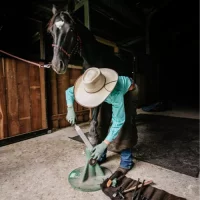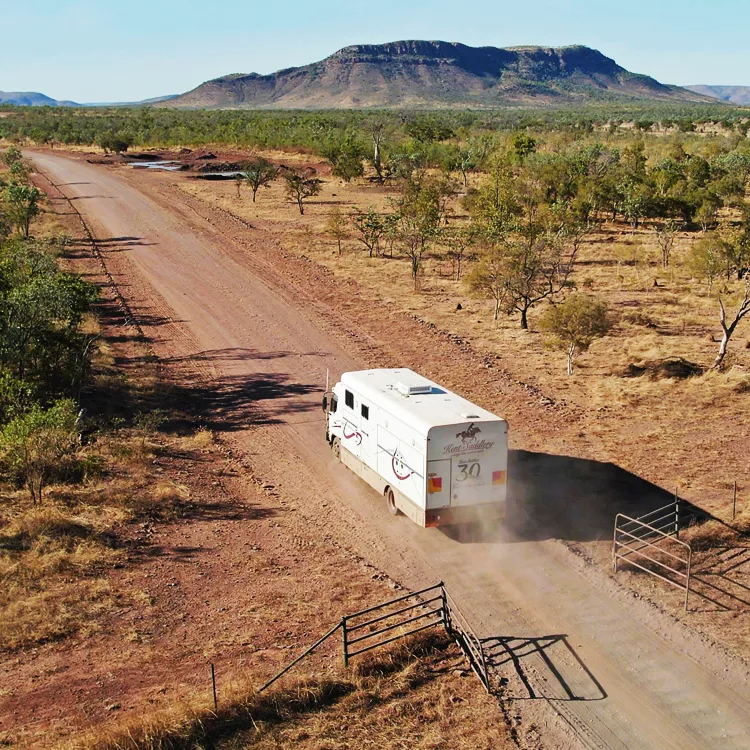Tom Cusack – Catalogue Article
Desert Drover
“I’ve worked a hard life, you know, yeah.” Tom Cusack, 78, is sitting in the comfort of the kitchen of Mittiebah Station, Northern Territory, where he tends the lawns, with yarns to share of desert droving, and the country which, “unless you’re a drover, you wouldn’t ever see.” Most photos of his droving days were destroyed by fire, but the memories remain, relived in enthusiastic conversation.
Tom’s childhood was spent on a dairy and grain farm, “south of Sandgate, Qld… five of us, hand milking one hundred cows twice each day.” In 1950, at 17½ years old, Tom came out bush, and went on his first drove with Splinter Dale, “to pick up 1500 store bullocks at Breadalbane Station, Bedourie, Qld, and take them to Frome Downs, South Australia. We travelled a distance of 930km, taking 8 weeks and 2 days.”
In those days, Splinter’s droving plant was typical, “…a 3 ton Dodge truck, loaded with three 44 gallon drums of petrol, the same of water, and stores, four sets of packs, leather gear and odds and ends. There were six in the camp; the cook, horse tailer, Boss Drover, and three ringers. We had a plant of forty-four horses. Us four riders had six working horses each, ten night horses, and ten pack horses. Over the years, droving camps became familiar for Tomas he travelled the stock routes of Nth West Australia, the Strzelecki, Simpson, Tanamiand Sturt Stony deserts, from Halls Creek in the Kimberley, to Birdsville, and the Yunta Railhead in South Australia. Valuable skills and knowledge were acquired; about the land, herbage, the seasons, animals, and people. “Life can be hard workin drifting sand hill country, with sand hills up to 40 metres high. When one sees white sand in the desert, it pays to go round it … there’s no bottom in it. If trucks became sand bogged, we used clumpers (pack horses) to pull them out. In a sand storm, sometimes you couldn’t see your horse’s head for dust. Sand storms can last from a few hours up to 4 or 5 days, and if you’re lost in one, twelve to twenty-four hours is your survival time without water.”
In 1958, Tom was part of a plant that drove 2000 store bullocks from Bull Creek Station (South West Qld), across Sturt Stony Desert … “Apple Country ’cos the rocks look like red apples. You had to be a good farrier…it’s murder for horses if they lose their shoes. We left the truck and used the packs to get across, … we saw brumbies in their tens of thousands, having a drink at nightfall at Lake Goyder. It was a pretty picture to see.” He adds, “When you’re in brumby country, the plant horses have to be tailed out and watched, because the brumby bucks will cut the mares out, and you won’t see them again.”
At times, Tom saw rabbits in their millions, “We shot a few for the pot, they are good curried up with rice. The dingoes ate them too… fat and shiny on the Strzelecki trackin a good season… and an odd albino dingo – all white in colour.” Floods in the channels around Birdsville also brought the drovers into close contact with other life forms. The cattle made tunnels through the lignum that grew alongside the flooded Diamantina, and all types of snakes and centipedes and goannas were all over the bushes. Tom had to ride his horse in the tunnels to keep the cattle moving; “How I wasn’t bitten by a snake beats me; they were in their thousands, all colours and sizes.”
Droving cattle required vigilance in the event of rushing cattle; skill and time required to control and settle them back into the mob. This was the case during a drove from Billiluna Station near Halls Creek, WA to the Plenty Highway, Urandangi, Qld. “At night time on their own country the cattle didn’t rush or stampede; but once we got over the border, they rushed all night. Paddy Fogarty (or Piebald Paddy, on account of all the different coloured horses he had in the plant) and I were the only ones in the camp who’d been with rushing cattle. That meant we worked all day and night, and would get only two hours sleep at the midday rest. I did that for seven months straight on that trip. One night, the cattle had quietened down a bit, it was 2 o’clock in the morning see, so two others took over. I had a white swag cover, and slept alongside the fire so the heat would blow over the swag. The cattle rushed …galloped and charged the camp fire and jumped right over my swag (because of the white swag cover!). I didn’t even know it’d happened, you know, yeah! I was dead to the world. When they told me next morning, I thought they were pulling my leg, but sure enough, I saw the cattle tracks where they propped on one side, and then landed on the other side of me swag.” At odd times when they rushed, I could woe them back from a gallop to a stop. If I talked to them, they’d get to know my voice, and then at night the sound of my voice could sometimes woe them to a stop. Paddy had some good night horses, … the night horse holds your life in his hand.”
Desert country droving was a secluded existence, and although Tom was engaged three times, “they wouldn’t come out bush with me, and I told them to go and get lost, you know.” Following a trip to Frome Downs, Bill Wilson, owner of Wertaloona Station, Flinders Ranges, suggested the men take two weeks holiday around Adelaide. “Whenever we went to a country town pub, we’d have on our best stockman hats, clothes and boots (maybe with a 3” Cuban heel … they made you stand up a little bit taller, you know), and people would ask us about life in the desert, and we couldn’t buy a round of drinks, they were all bought for us! So, it was good to see the other side of life.”
The extreme contrast of heat and cold was also part of desert droving, with temperatures ranging from below zero in the winter, to 200 degree F. in summer. “We’d see storms 50 to 60 miles ahead and expect to find green pick there, but when we arrived there’d be no sign of any rainfall. The ground is that hot it evaporates the rain before it reaches the ground. That’s Phantom Rain you know.”
Tom spent more recent years doing a bit of prospecting, and building and maintaining one thousand kilometres of fencing at Mittiebah Station, NT – camping out for weeks at a time. “Whenever I stopped, that’s where I camped. It’s nothing to be on me own.”
Its 47 years since Tom and the Fogarty boys made droving history by being the first to take cattle across the Simpson Desert from Billiluna Station, Halls Creek, WA to Mt Riddock Station, Alice Springs. Details of other droves remain fresh in Tom’s memory. “I’ve really enjoyed the bush life, and I wouldn’t change it for anything. It’s been a good life.”
For a more detailed account of Tom Cusack’s desert droving, see the Full Biography.
Image captions:
1) Mittiebah Station, 2008
2) Mananji Station, 1978
3) Wyndham Meatworks, 1982
4) Tom in 1996















